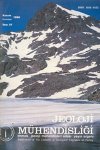
ABSTRACT: As is known, nativ and foreign geologists have been investigating onthe S W Anatolian since very early ages. There is no the geological evolution pattern of the SW Anatolian, up to now in spite of more data. However These knowledges aren`t extremely sufficient. According to data available, author have been tried, to propose the structural Items and the geological evolution of autochthonous, para-autochthonous and allochthonous of this region.
ABSTRACT: Mineral assemblages stable according to Gibbs phase rule can be shown, on the diagrams having axes such as P/T, log f/(i by the Schrein.emak.ers method,. These diagrams may be too complex on the basis of `the number of the components and the degreees of freedom in the system. A computer programme in BASIC language is developed in order to .solve such kind of complex systems which can be solved in. very long times with small calculators. This programme was adopted for the IBM-PC because of .the wide distributions of these computers, öne natural sample which was studied by the Scheinemakers method, is resolved by the proposed programme in order to show the application of programme. It is possible to obtain all the parameters of the system to be .solved by this computer programme `without any additional calculations.
ABSTRACT: Carbonate platforms evolved to rimmed, shelf from ramp and isolated platforms they are drowned with time. Commonly, we can. observe a transition from one type to another, Residental commuties be haves mainly as sediment .producers and as bafflers» trappers, and binders.. Carbonate ramps may be developed at times of tectonic or climatic crises,. Homoclinal ramps, develop on gently regional paleoslopes. Ramps with fringing banks may develop on paleoslopes with higher gradients than those with barrier banks., Distally steepened ramps develop where earlier rimmed shelves undergo widespread drowning,. Rimmed corbonate... shelves are mostly develop on continental shelves in low-latitude areas,, where reefal biota are abundant. High rate of upbuilding commonly associated with reefal biota, increases relief and steepens the margin. Margins may change with time to accretionary, bypass and erosional margins. Isolated platforms develop on rifted continental and transitional crust. Most oceanic atolls develop on subsiding oceanic volcanoes, Platforms undergo incipient or complete drowning where sea level rise or subsidence exceeds upbuilding. After rapid sea level rise buildups and rims shows three buildup phases; as a lag phase,, a catch-up phase and a keep-up phase. On the passive margins, corbonate platforms commonly develop over rift volcanics, immature elastics and evaporites. On convergent margins,, they show different evolution pattern.., The progradation of the platforms may be stopped by the volcanism, subsidence of the margins, the falling of the sea level and naturally lasting up of system through the time.
ABSTRACT: In Sivas basin a sequence, comprising detritic and evaporitic sedim.en.ts, approximately 6000 metres in thickness resting upon, a metamorphic and ophiolitic basement, crops out. In this sequence, the occurrences` of two different formations appropriate for being a hydrocarbon source rock: have been determined.. In the. basin, samples collected from, these units have been analyzed in la.borat.ori.es,, On the basis, of these analysis the. potentials of these formations for creation of petroleum .and natural gas,, have been, searched.
ABSTRACT: Triassic-Cretaceous aged Akdağ limestones and Burdigalian aged flysch unit occur at the basement,, Gölcük- Isparta around. In the vicinity of Gölcük, Pliocene, volcanism has an, .andezitic .and trachiandezitic character. Its products are lava, dyke and. pyrociastics. The volcanism. erupted several times,,, in the area. Pyroclaslic units in connection with the Gölcük volcanism are divided into volcanic brechia and. aglomerates, over volcano- sedimentary unit, pumice levels and. upper volcano-sedimentary unit. In. this pyroclastic unit, the pumice deposits present mainly in. two different horizons; block-bearing pumice and economic pumice, Pümice deposits formed depending on explosive trachi-andesitic volcanism. Gölcük-Isparta pumice deposits can supply for the light building materials needs of the central Mediterranean and Lakes districts, not only by their quality but also their reserves.
ABSTRACT: .As sonic waves propagate very well in water, acoustic methods are therefore the most valuable tool for sea bed - reconnaissance. Side scanning sonar is a powerful tool for precise and detailed investigation, of sea floor» for both, geological, and geotechnical purposes on continental shelves and in. deeper waters., Ultra sonic pulses (frequency range:: 30-100 kHz) are laterally transmitted at. regular` time, intervals, by one or two groups of transducers fitted in a tow `"fish."`,. The beam is a very narrow in the horizontal plane (I to 2°) and wider in. the vertical plane (10 to 40°). As the ship moves forward,, the sonic beam sweeps the sea floor. "Lateral sonars have no penetration and give only the visible details of the sea floor. The tool, is an. effective support in. the bathymetry,, sea floor1 geology,, sea floor engineering search (harbor and dredging studies, platform site investigation, cable and pipeline route selection.).,

 TMMOB
TMMOB